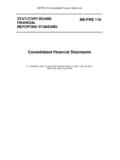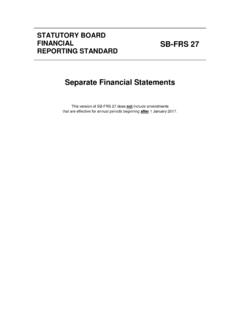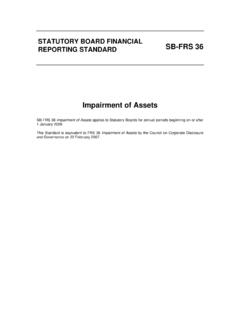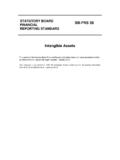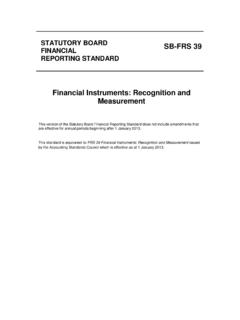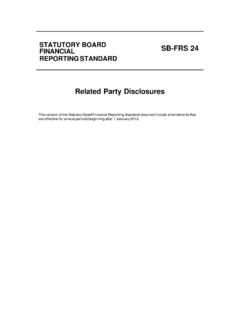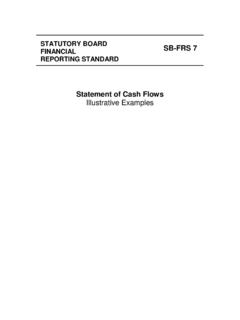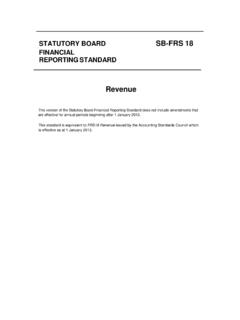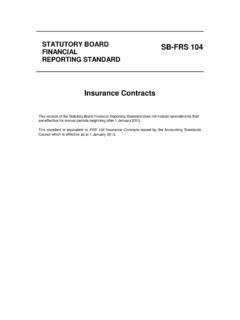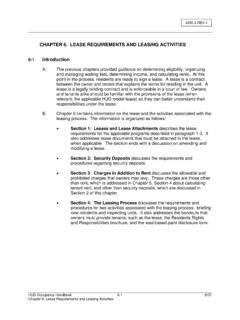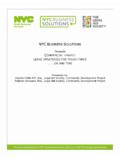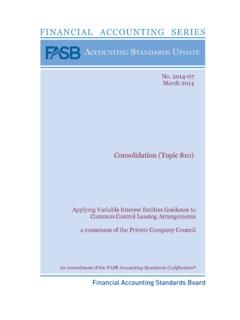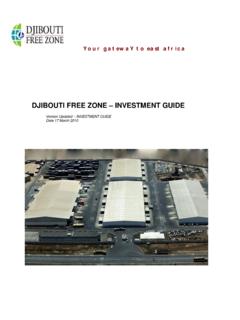Transcription of Leases - Accounting Standards for Statutory Boards - Home
1 Leases This standard applies for annual periods beginning on or after 1 January 2019. Earlier application is permitted. SB-FRS 116 Statutory BOARD FINANCIAL REPORTING STANDARD SB-FRS 116 2 CONTENTS Paragraphs INTRODUCTION OBJECTIVE 1 SCOPE 3 RECOGNITION EXEMPTIONS 5 IDENTIFYING A lease 9 Separating components of a contract 12 Lessee 13 Lessor 17 lease TERM 18 LESSEE 22 Recognition 22 Measurement 22 Initial measurement 23 Subsequent measurement 29 Presentation 47 Disclosure 51 LESSOR 61 Classification of Leases 61 Finance Leases 67 Recognition and measurement 67 Operating Leases 81 Recognition and measurement 81 Presentation 88 Disclosure 89 Finance Leases 93 Operating Leases 95 SALE AND LEASEBACK TRANSACTIONS 98 SB-FRS 116 3 Assessing whether the transfer of the asset is a sale 99 Transfer of the asset is a sale 100 Transfer of the asset is not a sale 103 APPENDICES A Defined terms
2 B Application guidance C Effective date and transition D Amendments to other Standards ILLUSTRATIVE EXAMPLES (see separate document) SB-FRS 116 4 Statutory Board Financial Reporting Standard 116 Leases (SB-FRS 116) is set out in paragraphs 1 103 and Appendices A D. All the paragraphs have equal authority. Paragraphs in bold type state the main principles. Terms defined in Appendix A are in italics the first time that they appear in the Standard. The Standard should be read in the context of its objective the Preface to Statutory Board Financial Reporting Standards and the Conceptual Framework for Financial Reporting. SB-FRS 8 Accounting Policies, Changes in Accounting Estimates and Errors provides a basis for selecting and applying Accounting policies in the absence of explicit guidance. SB-FRS 116 5 Introduction Overview IN1 Statutory Board Financial Reporting Standard 116 Leases (SB-FRS 116) sets out the principles for the recognition, measurement, presentation and disclosure of Leases .
3 The objective is to ensure that lessees and lessors provide relevant information in a manner that faithfully represents those transactions. This information gives a basis for users of financial statements to assess the effect that Leases have on the financial position, financial performance and cash flows of the entity. IN2 SB-FRS 116 is effective for annual periods beginning on or after 1 January 2019. Earlier application is permitted for entities that apply SB-FRS 115 Revenue from Contracts with Customers at or before the date of initial application of SB-FRS 116. IN3 SB-FRS 116 supersedes: (a) SB-FRS 17 Leases ; (b) INT SB-FRS 104 Determining whether an Arrangement contains a lease ; (c) INT SB-FRS 15 Operating Leases Incentives; and (d) INT SB-FRS 27 Evaluating the Substance of Transactions Involving the Legal Form of a lease .
4 Reasons for issuing SB-FRS 116 IN4 Leasing is an important activity for many entities. It is a means of gaining access to assets, of obtaining finance and of reducing an entity s exposure to the risks of asset ownership. The prevalence of leasing means that it is important that users of financial statements have a complete and understandable picture of an entity s leasing activities. IN5 The previous Accounting model for Leases required lessees and lessors to classify their Leases as either finance Leases or operating Leases and account for those two types of Leases differently. That model was criticised for failing to meet the needs of users of financial statements because it did not always provide a faithful representation of leasing transactions. In particular, it did not require lessees to recognise assets and liabilities arising from operating Leases .
5 IN6 The new approach to lease Accounting under SB-FRS 116 requires a lessee to recognise assets and liabilities for the rights and obligations created by Leases (with limited exceptions). This approach will result in a more faithful representation of a lessee s assets and liabilities and, together with enhanced disclosures, will provide greater transparency of a lessee s financial leverage and capital employed. IN7 [Not used] IN8 [Not used] IN9 [Not used] SB-FRS 116 6 Main features Lessee Accounting IN10 SB-FRS 116 introduces a single lessee Accounting model and requires a lessee to recognise assets and liabilities for all Leases with a term of more than 12 months, unless the underlying asset is of low value. A lessee is required to recognise a right-of-use asset representing its right to use the underlying leased asset and a lease liability representing its obligation to make lease payments.
6 IN11 A lessee measures right-of-use assets similarly to other non-financial assets (such as property, plant and equipment) and lease liabilities similarly to other financial liabilities. As a consequence, a lessee recognises depreciation of the right-of-use asset and interest on the lease liability, and also classifies cash repayments of the lease liability into a principal portion and an interest portion and presents them in the statement of cash flows applying SB-FRS 7 Statement of Cash Flows. IN12 Assets and liabilities arising from a lease are initially measured on a present value basis. The measurement includes non-cancellable lease payments (including inflation-linked payments), and also includes payments to be made in optional periods if the lessee is reasonably certain to exercise an option to extend the lease , or not to exercise an option to terminate the lease .
7 IN13 SB-FRS 116 contains disclosure requirements for lessees. Lessees will need to apply judgement in deciding upon the information to disclose to meet the objective of providing a basis for users of financial statements to assess the effect that Leases have on the financial position, financial performance and cash flows of the lessee. Lessor Accounting IN14 SB-FRS 116 substantially carries forward the lessor Accounting requirements in SB-FRS 17. Accordingly, a lessor continues to classify its Leases as operating Leases or finance Leases , and to account for those two types of Leases differently. IN15 SB-FRS 116 also requires enhanced disclosures to be provided by lessors that will improve information disclosed about a lessor s risk exposure, particularly to residual value risk. SB-FRS 116 7 Statutory Board Financial Reporting Standard 116 Leases Objective 1 This Standard sets out the principles for the recognition, measurement, presentation and disclosure of Leases .
8 The objective is to ensure that lessees and lessors provide relevant information in a manner that faithfully represents those transactions. This information gives a basis for users of financial statements to assess the effect that Leases have on the financial position, financial performance and cash flows of an entity. 2 An entity shall consider the terms and conditions of contracts and all relevant facts and circumstances when applying this Standard. An entity shall apply this Standard consistently to contracts with similar characteristics and in similar circumstances. Scope 3 An entity shall apply this Standard to all Leases , including Leases of right-of-use assets in a sublease, except for: (a) Leases to explore for or use minerals, oil, natural gas and similar non-regenerative resources; (b) Leases of biological assets within the scope of SB-FRS 41 Agriculture held by a lessee; (c) service concession arrangements within the scope of INT SB-FRS 112 Service Concession Arrangements; (d) licences of intellectual property granted by a lessor within the scope of SB-FRS 115 Revenue from Contracts with Customers; and (e) rights held by a lessee under licensing agreements within the scope of SB-FRS 38 Intangible Assets for such items as motion picture films, video recordings, plays, manuscripts, patents and copyrights.
9 4 A lessee may, but is not required to, apply this Standard to Leases of intangible assets other than those described in paragraph 3(e). Recognition exemptions (paragraphs B3 B8) 5 A lessee may elect not to apply the requirements in paragraphs 22 49 to: (a) short-term Leases ; and (b) Leases for which the underlying asset is of low value (as described in paragraphs B3 B8). 6 If a lessee elects not to apply the requirements in paragraphs 22 49 to either short-term Leases or Leases for which the underlying asset is of low value, the lessee shall recognise the lease payments associated with those Leases as an expense on either a straight-line basis over the lease term or another systematic basis. The lessee shall apply another systematic basis if that basis is more representative of the pattern of the lessee s benefit. 7 If a lessee accounts for short-term Leases applying paragraph 6, the lessee shall consider the lease to be a new lease for the purposes of this Standard if: (a) there is a lease modification; or SB-FRS 116 8 (b) there is any change in the lease term (for example, the lessee exercises an option not previously included in its determination of the lease term).
10 8 The election for short-term Leases shall be made by class of underlying asset to which the right of use relates. A class of underlying asset is a grouping of underlying assets of a similar nature and use in an entity s operations. The election for Leases for which the underlying asset is of low value can be made on a lease -by- lease basis. Identifying a lease (paragraphs B9 B33) 9 At inception of a contract, an entity shall assess whether the contract is, or contains, a lease . A contract is, or contains, a lease if the contract conveys the right to control the use of an identified asset for a period of time in exchange for consideration. Paragraphs B9 B31 set out guidance on the assessment of whether a contract is, or contains, a lease . 10 A period of time may be described in terms of the amount of use of an identified asset (for example, the number of production units that an item of equipment will be used to produce).
